Grocery store chain Sprouts Farmers Market (NASDAQ:SFM) beat analysts' expectations in Q1 CY2024, with revenue up 8.7% year on year to $1.88 billion. It made a non-GAAP profit of $1.12 per share, improving from its profit of $0.98 per share in the same quarter last year.
Sprouts (SFM) Q1 CY2024 Highlights:
- Revenue: $1.88 billion vs analyst estimates of $1.85 billion (1.9% beat)
- EPS (non-GAAP): $1.12 vs analyst estimates of $1.01 (11.3% beat)
- EPS (non-GAAP) Guidance for Q2 CY2024 is $0.77 at the midpoint, above analyst estimates of $0.72
- EPS (non-GAAP) Guidance for full year 2024 is $3.09 at the midpoint, above analyst estimates of $2.95 (4.7% beat)
- Gross Margin (GAAP): 38.3%, up from 37.5% in the same quarter last year
- Free Cash Flow of $168.5 million, up 26.9% from the same quarter last year
- Same-Store Sales were up 4% year on year (beat vs. expectations of up 3.2% year on year)
- Store Locations: 414 at quarter end, increasing by 19 over the last 12 months
- Market Capitalization: $6.66 billion
Playing on the secular trend of healthier living, Sprouts Farmers Market (NASDAQ:SFM) is a grocery store chain emphasizing natural and organic products.
Because of this focus on health, a shopper at Sprouts can find more depth and breadth in areas like organic produce, meats free from added hormones, natural foods such as cereals and juices, and vitamins. In addition to a focus on healthy foods, Sprouts also offers reasonable prices. The company does this by sourcing directly from farmers and other producers, which minimizes middlemen and the costs associated with them. In addition, Sprouts emphasizes its private label products, which are produced by contracted manufacturers and cheaper than brand-name products.
The average size of a Sprouts Farmers Market store is around 30,000 square feet, and most stores are located in suburban areas. The stores are laid out in a farmer's market style, with fresh produce and bakery items prominently displayed at the front of the store. The perimeter and back of the store typically has refrigerators and freezers with items like milk, yogurt, frozen vegetables, and packaged meat.
Sprouts Farmers Market launched its e-commerce presence in 2020, which was expedited due to the COVID-19 pandemic. Customers can now order groceries online and either pick them up in-store or have them delivered.
Grocery Store
Grocery stores are non-discretionary because they sell food, an essential staple for life (maybe not that ice cream?). Selling food, however, is a notoriously tough business as grocers must deal with the costs of procuring and transporting oftentimes perishable products. Plus, the costs of operating stores to sell everything from raw meat to ice cream and fresh fruit are high. Competition is also fierce because grocers and other peers such as wholesale clubs tend to sell very similar brands and products. On the bright side, grocery is one of the least penetrated categories in e-commerce because customers prefer to buy their food in person. Still, the online threat exists and will likely increase over time rather than dwindle.
Grocery competitors with a total or partial focus on healthier options include Amazon.com’s Whole Foods market (NASDAQ:AMZN), Kroger (NYSE:KR), and private company Trader Joe’s.Sales Growth
Sprouts is larger than most consumer retail companies and benefits from economies of scale, giving it an edge over its competitors.
As you can see below, the company's annualized revenue growth rate of 5.5% over the last five years was weak , but to its credit, it opened new stores and grew sales at existing, established stores.
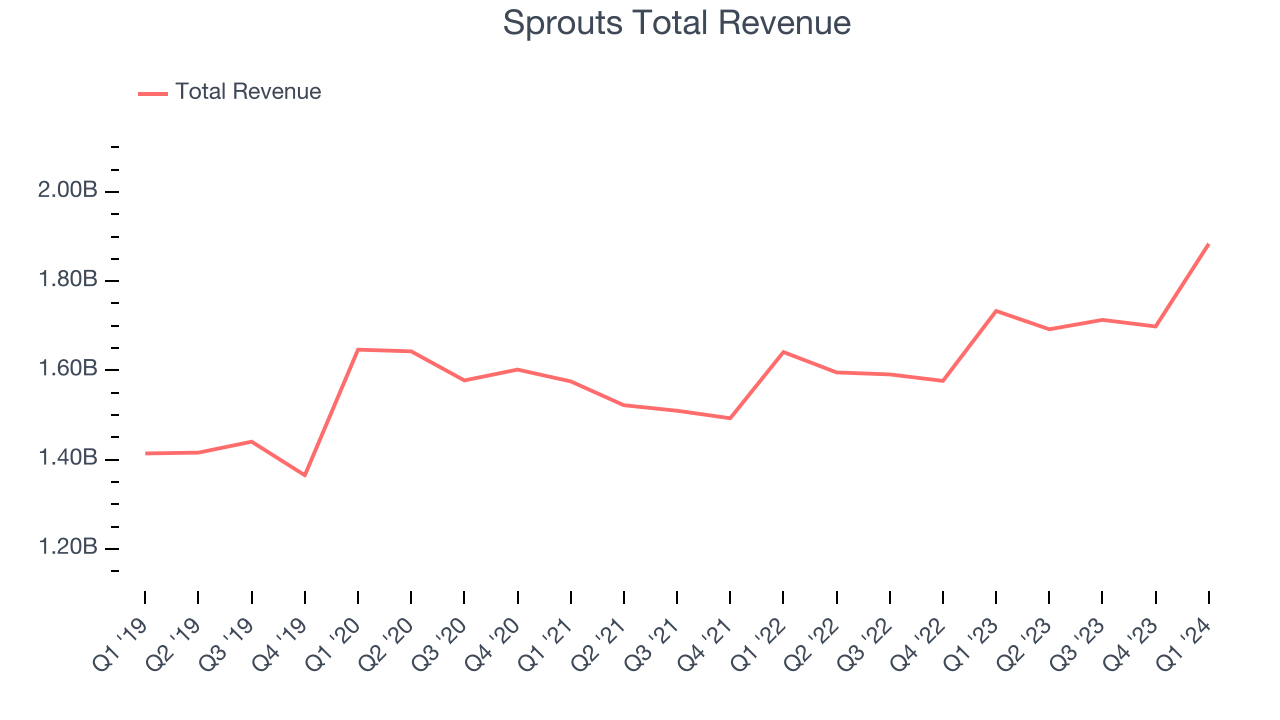
This quarter, Sprouts reported solid year-on-year revenue growth of 8.7%, and its $1.88 billion in revenue outperformed Wall Street's estimates by 1.9%. Looking ahead, Wall Street expects sales to grow 7.2% over the next 12 months, a deceleration from this quarter.
Same-Store Sales
Same-store sales growth is an important metric that tracks demand for a retailer's established brick-and-mortar stores and e-commerce platform.
Sprouts's demand within its existing stores has generally risen over the last two years but lagged behind the broader consumer retail sector. On average, the company's same-store sales have grown by 3.1% year on year. With positive same-store sales growth amid an increasing physical footprint of stores, Sprouts is reaching more customers and growing sales.
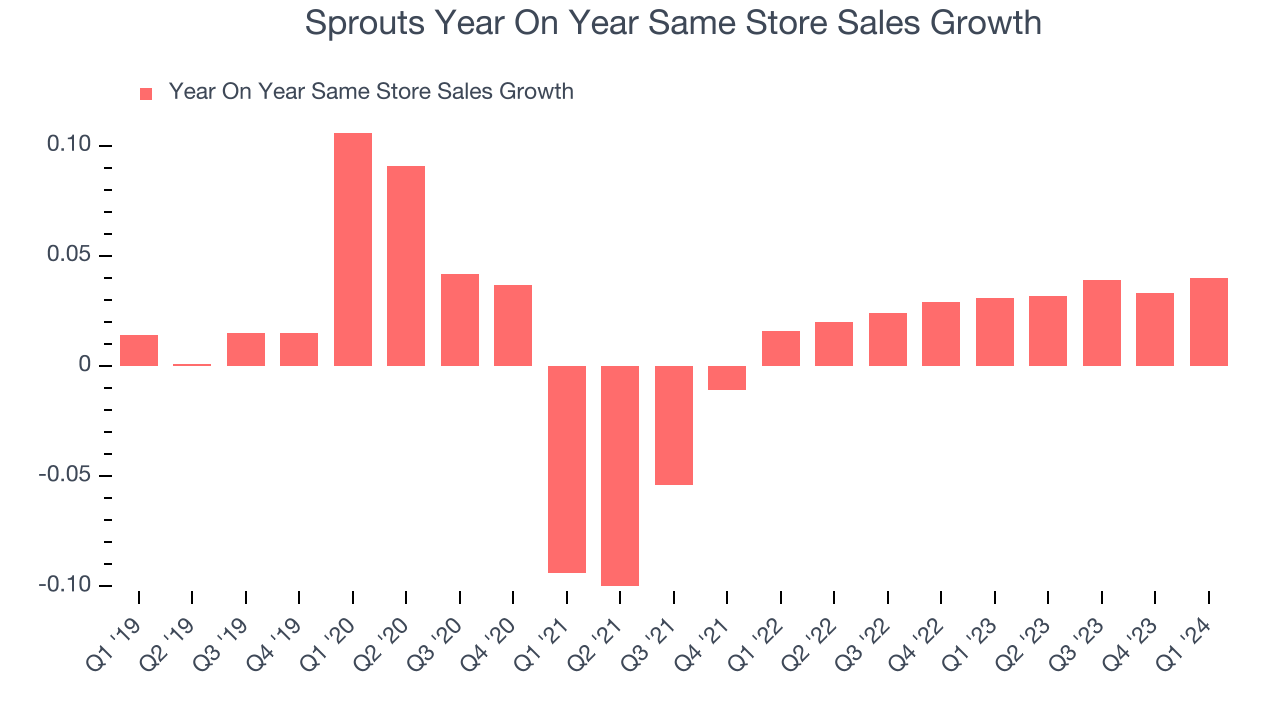
In the latest quarter, Sprouts's same-store sales rose 4% year on year. This performance was more or less in line with the same quarter last year.
Number of Stores
When a retailer like Sprouts is opening new stores, it usually means it's investing for growth because demand is greater than supply. Sprouts's store count increased by 19 locations, or 4.8%, over the last 12 months to 414 total retail locations in the most recently reported quarter.
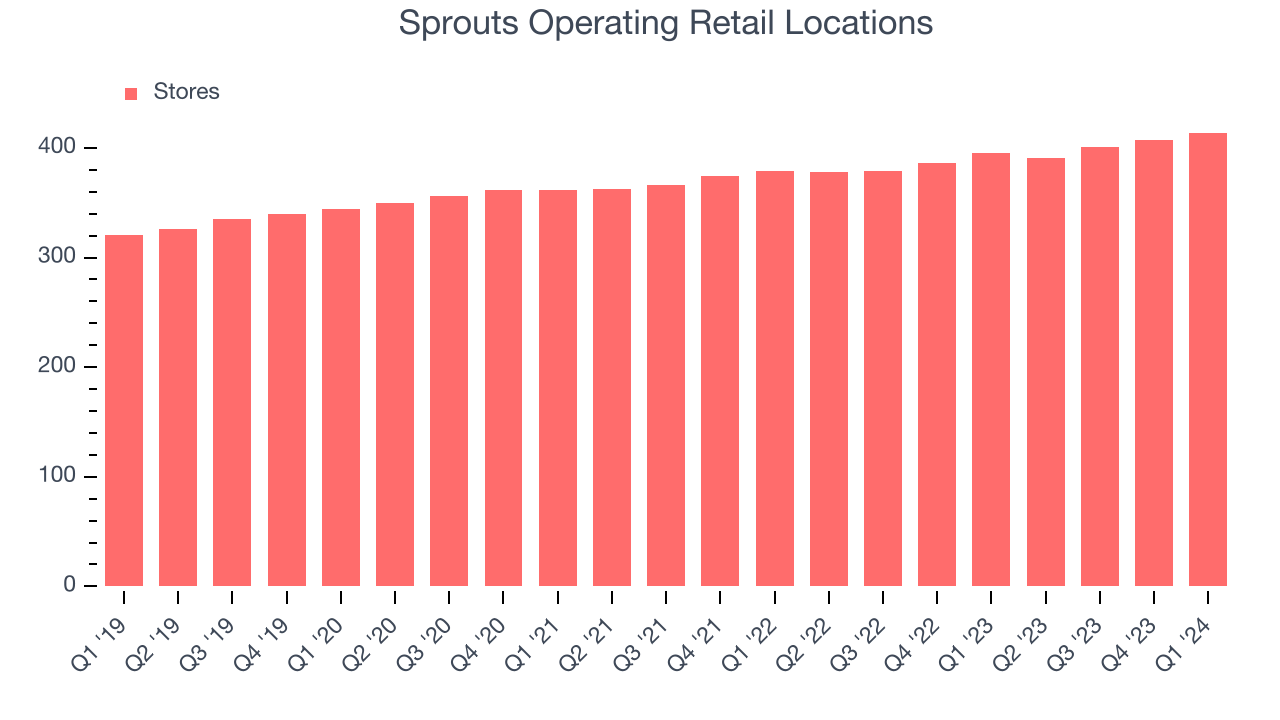
Taking a step back, the company has generally opened new stores over the last eight quarters, averaging 4.3% annual growth in its physical footprint. This is decent store growth and in line with other retailers. With an expanding store base and demand, revenue growth can come from multiple vectors: sales from new stores, sales from e-commerce, or increased foot traffic and higher sales per customer at existing stores.
Gross Margin & Pricing Power
Gross profit margins are an important measure of a retailer's pricing power, product differentiation, and negotiating leverage.
Sprouts's unit economics are higher than the typical retailer, giving it the flexibility to invest in areas such as marketing and talent to reach more consumers. As you can see below, it's averaged a decent 37.2% gross margin over the last eight quarters. However, when comparing its margin specifically to other non-discretionary retailers, it's best in class. That's because non-discretionary retailers have structurally lower gross margins as they compete to provide the lowest possible price, sell products easily found elsewhere, and have high transportation costs to move their goods. We believe the best metrics to assess these types of companies are free cash flow margin, operating leverage, and profit volatility, which take their scale advantages and non-cyclical demand characteristics into account.
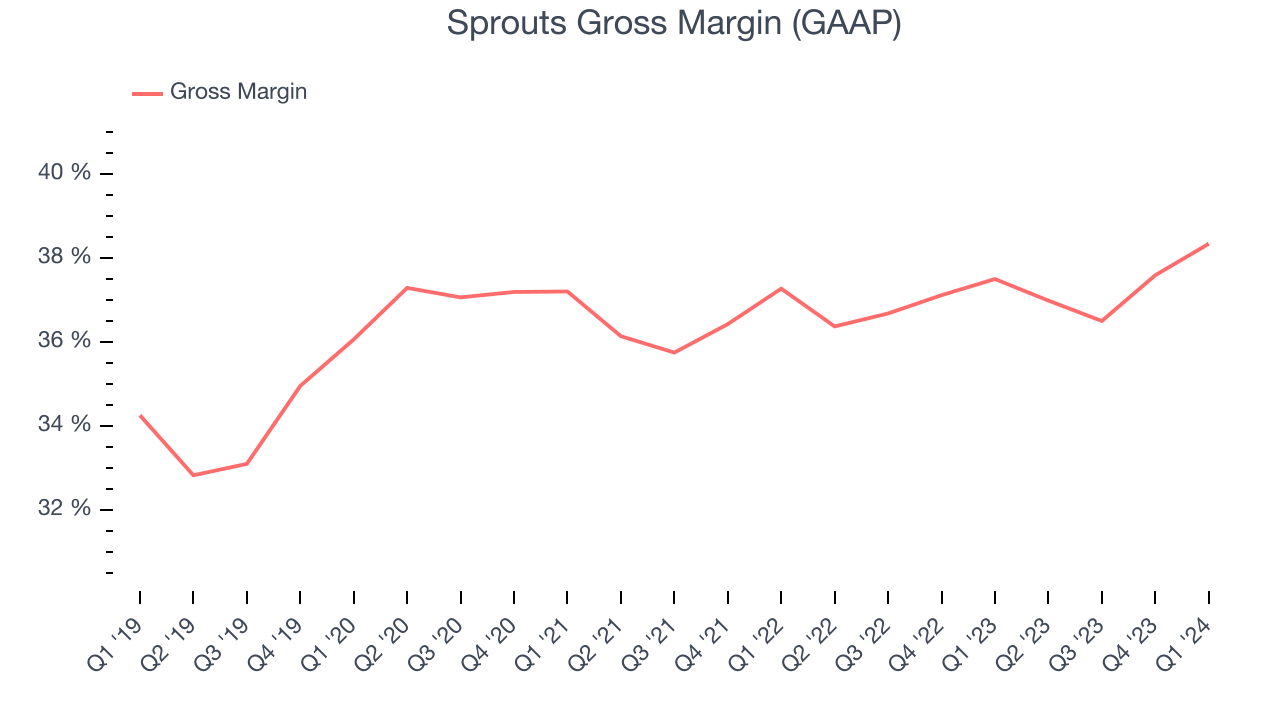
Sprouts produced a 38.3% gross profit margin in Q1, flat with the same quarter last year. This steady margin for a retailer like Sprouts, which is structurally less profitable than the typical retail business for the reasons mentioned above, signals that it has stable input costs (such as freight expenses to transport goods) and aims to keep prices low for consumers.
Operating Margin
Operating margin is an important measure of profitability for retailers as it accounts for all expenses keeping the lights on, including wages, rent, advertising, and other administrative costs.
In Q1, Sprouts generated an operating profit margin of 7.9%, up 2 percentage points year on year. This increase was encouraging, and we can infer Sprouts was more disciplined with its expenses or gained leverage on fixed costs because its operating margin expanded more than its gross margin.
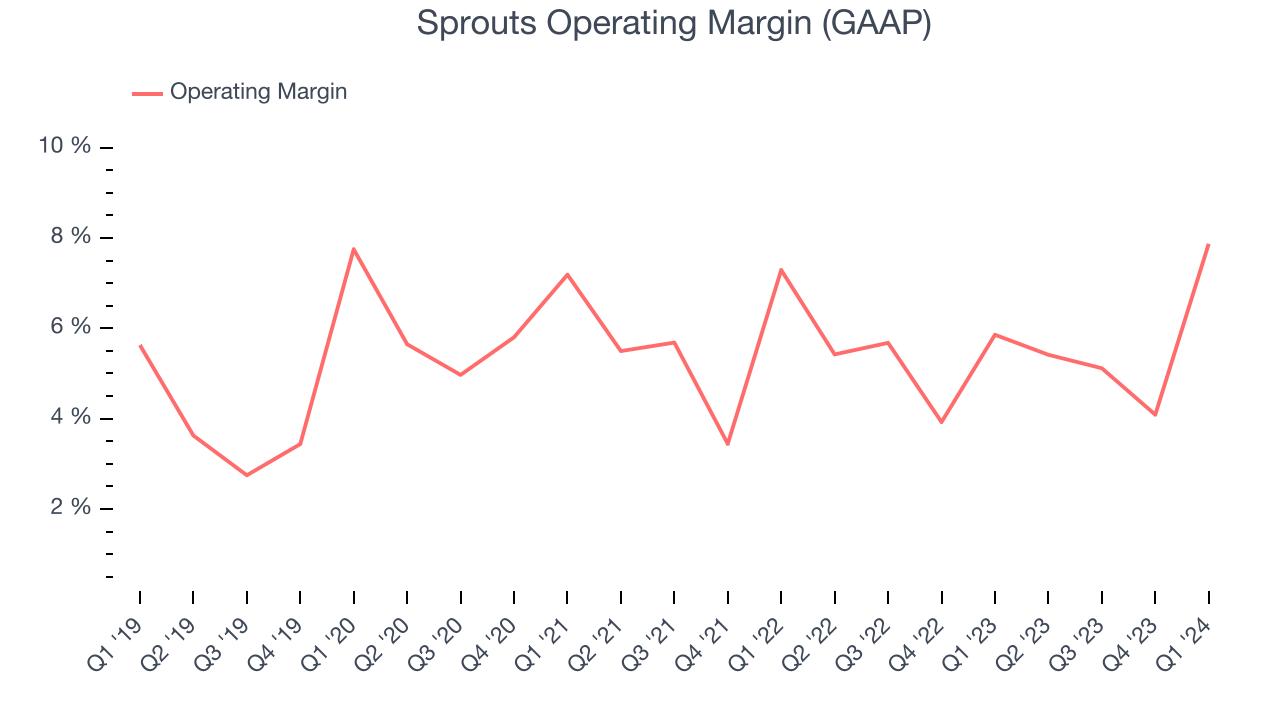 Zooming out, Sprouts was profitable over the last eight quarters but held back by its large expense base. It's demonstrated subpar profitability for a consumer retail business, producing an average operating margin of 5.5%. Its margin has also seen few fluctuations, meaning it will take a big change to improve profitability.
Zooming out, Sprouts was profitable over the last eight quarters but held back by its large expense base. It's demonstrated subpar profitability for a consumer retail business, producing an average operating margin of 5.5%. Its margin has also seen few fluctuations, meaning it will take a big change to improve profitability.EPS
These days, some companies issue new shares like there's no tomorrow. That's why we like to track earnings per share (EPS) because it accounts for shareholder dilution and share buybacks.
In Q1, Sprouts reported EPS at $1.12, up from $0.98 in the same quarter a year ago. This print beat Wall Street's estimates by 11.3%.
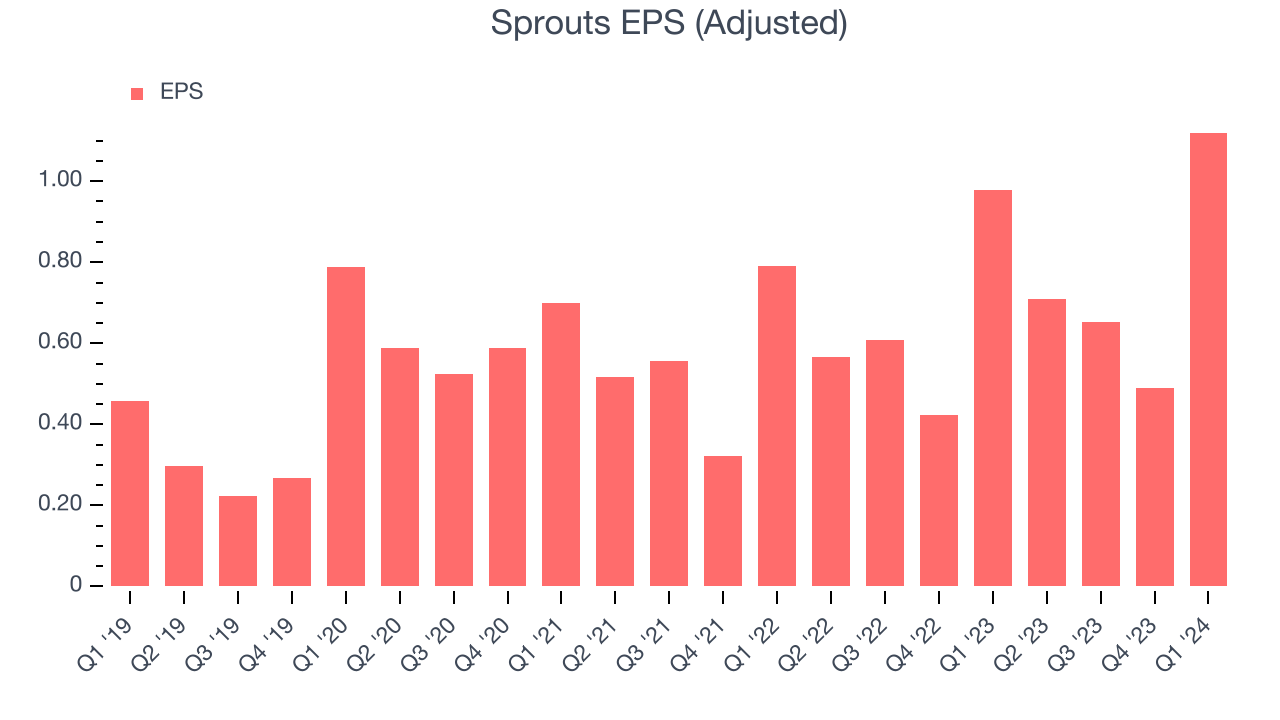
Wall Street expects the company to continue growing earnings over the next 12 months, with analysts projecting an average 1.8% year-on-year increase in EPS.
Cash Is King
If you've followed StockStory for a while, you know that we emphasize free cash flow. Why, you ask? We believe in the end, cash is king, and you can't use accounting profits to pay the bills.
Sprouts's free cash flow came in at $168.5 million in Q1, up 26.9% year on year. This result represents a 8.9% margin.
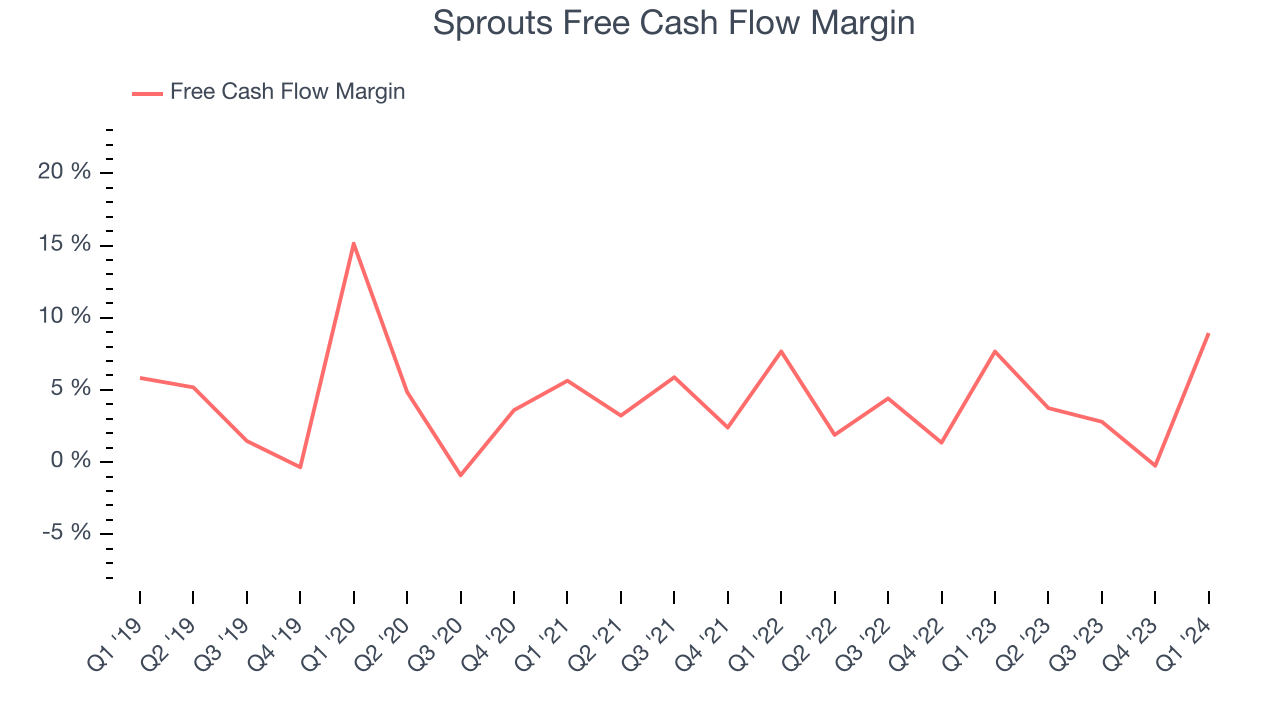
Over the last two years, Sprouts has shown decent cash profitability, giving it some reinvestment opportunities. The company's free cash flow margin has averaged 3.9%, slightly better than the broader consumer retail sector. Furthermore, its margin has been flat, showing that the company's cash flows are relatively stable.
Return on Invested Capital (ROIC)
EPS and free cash flow tell us whether a company was profitable while growing revenue. But was it capital-efficient? Enter ROIC, a metric showing how much operating profit a company generates relative to how much money the business raised (debt and equity).
Sprouts's five-year average ROIC was 14.2%, somewhat low compared to the best retail companies that consistently pump out 25%+. Its returns suggest it historically did a subpar job investing in profitable business initiatives.
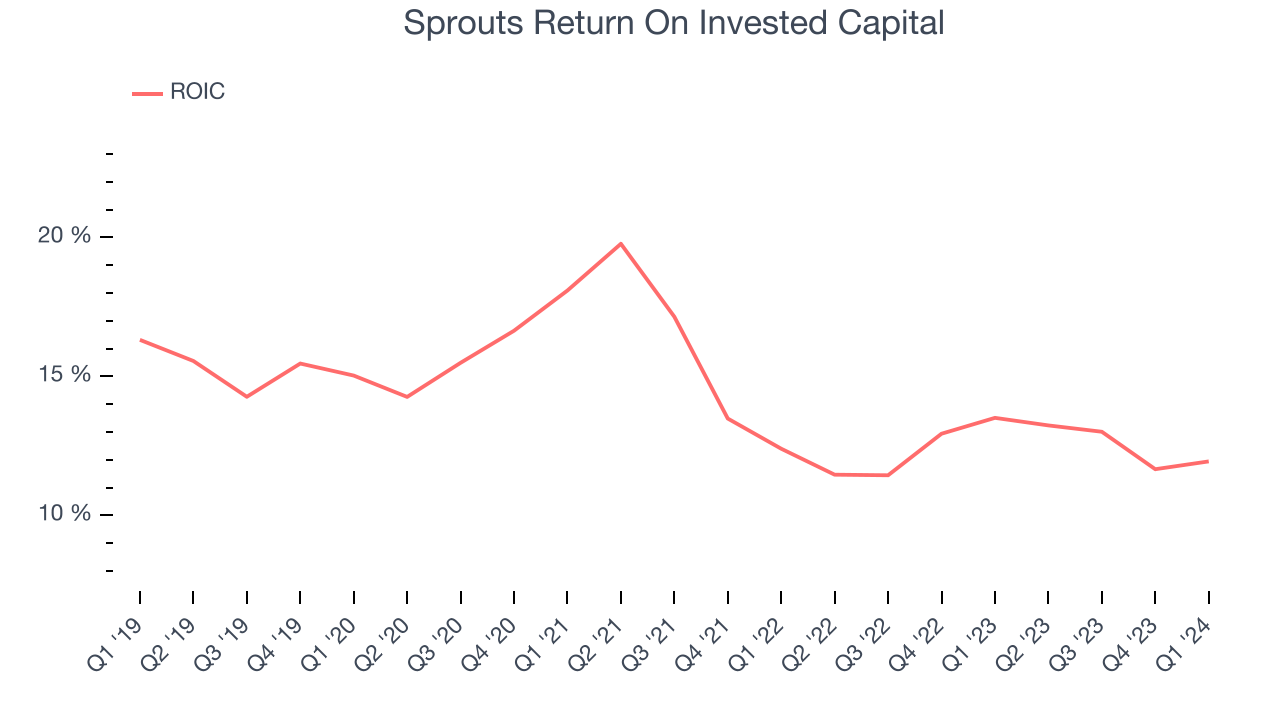
The trend in its ROIC, however, is often what surprises the market and drives the stock price. Unfortunately, Sprouts's ROIC averaged 3.8 percentage point decreases over the last few years. Paired with its already low returns, these declines suggest the company's profitable business opportunities are few and far between.
Balance Sheet Risk
Debt is a tool that can boost company returns but presents risks if used irresponsibly.
Sprouts reported $312.3 million of cash and $1.57 billion of debt on its balance sheet in the most recent quarter. As investors in high-quality companies, we primarily focus on two things: 1) that a company's debt level isn't too high and 2) that its interest payments are not excessively burdening the business.
With $543 million of EBITDA over the last 12 months, we view Sprouts's 2.3x net-debt-to-EBITDA ratio as safe. We also see its $3.45 million of annual interest expenses as appropriate. The company's profits give it plenty of breathing room, allowing it to continue investing in new initiatives.
Key Takeaways from Sprouts's Q1 Results
The company reported same store sales above expectations, leading to a revenue and ultimately an EPS beat. We were also impressed by Sprouts's optimistic earnings forecast for next quarter and the full year, which beat analysts' expectations. Zooming out, we think this was a great quarter that shareholders will appreciate. The stock is up 4.5% after reporting and currently trades at $67.15 per share.
Is Now The Time?
Sprouts may have had a good quarter, but investors should also consider its valuation and business qualities when assessing the investment opportunity.
Sprouts isn't a bad business, but it probably wouldn't be one of our picks. Its revenue growth has been a little slower over the last five years, but at least growth is expected to increase in the short term. And while its stable growth in physical locations shows it has steady demand, the downside is its poor same-store sales performance has been a headwind. On top of that, its operating margins are below average compared to other retailers.
Sprouts's price-to-earnings ratio based on the next 12 months is 21.2x. We can find things to like about Sprouts and there's no doubt it's a bit of a market darling, at least for some investors. But it seems there's a lot of optimism already priced in and we wonder if there are better opportunities elsewhere right now.
Wall Street analysts covering the company had a one-year price target of $58.24 per share right before these results (compared to the current share price of $67.15), implying they didn't see much short-term potential in Sprouts.
To get the best start with StockStory, check out our most recent stock picks, and then sign up to our earnings alerts by adding companies to your watchlist here. We typically have the quarterly earnings results analyzed within seconds of the data being released, and especially for companies reporting pre-market, this often gives investors the chance to react to the results before the market has fully absorbed the information.
